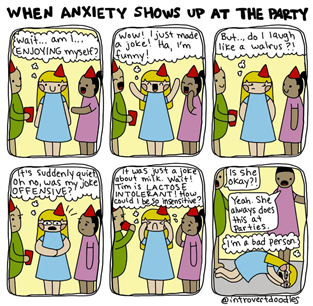Social Anxiety Disorder (Social Phobia)
Advanced Therapeutic Solutions for Anxiety provides exposure therapy for the treatment of Social Anxiety Disorder.
Social Anxiety Disorder (Social Phobia) is a persistent and consistent fear of negative evaluation from others. To minimize the fear, individuals with social anxiety will avoid being in a situation where scrutiny from others is possible, for example calling in sick to avoid giving a presentation, avoiding social gatherings, or turning down employment opportunities because it requires presenting in meetings. Feared outcomes include saying something wrong or offensive, acting in a way that will feel humiliating, showing anxiety symptoms (e.g., blushing, sweating, trembling, stumbling over words) which will be perceived as weak, crazy, dumb, unlikeable, etc. If the situation cannot be avoided, then it is endured with intense anxiety, sometimes even leading to an anxiety attack or panic attack, creating more embarrassment, and deepening the fear. Feared tasks can include:
- Social interactions (e.g., having or starting a conversation, meeting new people)
- Being observed (e.g., eating or drinking in front of others; writing in front of others)
- Urinating in public bathrooms when others are present (“shy bladder syndrome”)
- Performing in front of others (e.g, giving a speech or presentation, performing in school programs)
People with social anxiety learn ways to reduce their anxiety, such as seeking reassurance from others or over-preparing for a task, but oftentimes, these strategies are short-lived because they interfere with learning, feed the anxious-avoidance loop, and make their fear of negative judgment worse.
Social anxiety is not due to a lack of social skills; in fact, many people with social anxiety have in-tact social skills, but they underestimate their ability while overestimating others' negative judgments, creating more anxiety that interferes with functioning and feeds negative core beliefs (e.g., "I'm a bad person"), which is what needs to be targeted in therapy. The @introvertdoodles.com comic on this page is a great example.
Treatment for social anxiety involves cognitive behavioral therapy (CBT) to identify the negative core beliefs, identify the predictions of fearful outcomes, behavioral experiments to test core beliefs and gather new data, and learning what safety behaviors pop up while engaging in the behavioral experiment. Therefore, treatment involves exposure therapy to extinguish the fear, coupled with cognitive behavioral therapy and acceptance and commitment therapy to identify negative core beliefs and focus on healthy/balanced beliefs.
Call now for a free 30-min Consultation
Clinical Procedures for Social Anxiety Disorder (Social Phobia) Evaluation and Outpatient Treatment
Free Phone Intake Consultation
Up to 30-min phone consultation so we can hear about your presenting issue, the symptoms you are experiencing, when they started, the severity of symptoms, and if we are the appropriate place for your treatment. The diagnostic intake process is discussed, and your insurance/billing questions are answered. If the treatment you need is within our scope of services, we begin the scheduling process. If it is deemed that we are not the appropriate place, we will provide you with referrals and resources to help you. We want to make sure to connect you with services, and that includes helping you find treatment elsewhere if that's what you need.
Free
CPT CODE: 0
Diagnostic Evaluation
A 90-min diagnostic interview is conducted to assess the presenting problem, symptoms severity (onset, duration, frequency), review areas of life that have been impacted (daily functioning, work, home), collect history, including family history of anxiety or depression, and review what you hope to gain from treatment at ATSA. Specific questions and or measures may be administered during the session for diagnostic purposes.
Starting at 295
CPT CODE: 90791
Treatment Planning Session
A 60-min session to review how the first sessions have felt to you, present hypotheses, and collaborate on a treatment plan. Treatment approaches may include Acceptance and Commitment Therapy (ACT), Cognitive Behavioral Therapy (CBT), Exposure and Response Prevention (ERP). Treatment dose is also discussed, specifically if weekly 60-min outpatient sessions will be effective, or if intensive doses (e.g., 3-hr sessions) should be considered. Likewise, location of where sessions should occur for most effective outcome is also discussed and planned out. Decisions are made as to whether to start with therapy sessions only, allowing for the future addition of psychopharmacological treatment as an adjunct, or whether to start with combined treatment, (or in rare cases to start with psychopharmacological treatment before CBT, ACT, or ERP).
Starting at 175
CPT CODE: 90837
Exposure Clinic Session
60 min exposure sessions to present you with the phobic stimulus and begin the process of fear extinction. The key to exposure therapy is to activate new learning, which is done by presenting the phobic stimulus, and assisting you to approach (vs avoid) the stimulus, using a hierarchical approach. With repeated exposures, you gain distress tolerance and fear extinction. Additional therapies (e.g., ACT, CBT) may be applied to keep you focused and motivated in preparation for exposures, particularly when exposures become more challenging as we move up the hierarchy. When possible, family members will be included to learn how to facilitate approach coping and reduce enabling avoidance. Our data show that when family members learn how to support you, you are more likely to maintain your treatment gains.
Starting at 175
CPT CODE: 90837
Exposure Therapy in Home or Community Settings
60-min exposure sessions provided in the home or community setting to help transfer treatment gains into these domains. To increase transfer of treatment gains, reduce avoidance of the phobia across settings, and reduce others rescuing you from approaching your phobia (to rescue you from distress), in-vivo and in-situ exposure therapy is most effective. Not only will you develop distress tolerance, new learning, and fear extinction, so will others in these settings, which helps them reduce rescuing and enabling. Home visits are used to help you use skills at home, and Community sessions provide exposure practice in new settings.
Starting at 185 + travel
CPT CODE: 90837
